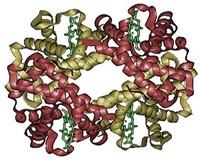 |
Durham, N.C. (UPI) Oct 12, 2009 U.S. bioengineers say they have successfully mimicked the way embryonic stem cells develop into heart muscle in a lab study. Duke University researchers say their achievement using mouse embryonic stem cells is a important first step toward growing a living "heart patch" to repair heart tissue damaged by disease. The scientists said they used a novel mold of their own design to fashion a three-dimensional "patch" made up of heart muscle cells, known as cardiomyocytes. The new tissue exhibited the two most important attributes of heart muscle cells -- the ability to contract and to conduct electrical impulses. Researchers said they also found cardiomyocytes flourished only in the presence of a class of "helper" cells known as cardiac fibroblasts, which comprise as much as 60 percent of all cells present in a human heart. "When we tested the patch, we found that because the cells aligned themselves in the same direction, they were able to contract like native cells," said Brian Liau, a graduate student who presented the study in Pittsburgh last week during a meeting of the Biomedical Engineering Society. "They were also able to carry the electrical signals that make cardiomyocytes function in a coordinated fashion." Professor Nenad Bursac, who led the research, said he believes the experiments represent a proof-of-principle advance, but said there are still many hurdles that must be overcome before such patches could be implanted into humans with heart disease. Share This Article With Planet Earth
Related Links Hospital and Medical News at InternDaily.com
 Gene affecting hemoglobin is identified
Gene affecting hemoglobin is identifiedLondon (UPI) Oct 12, 2009 British scientists say they've identified a gene that has a significant effect on regulating hemoglobin in the body. The achievement came during a genome-wide association study conducted by Imperial College London researchers who looked at the link between genes and hemoglobin level in 16,000 people. It shows a strong association between a gene known as TMPRSS6 and the regulation of ... read more |
|
| The content herein, unless otherwise known to be public domain, are Copyright 1995-2009 - SpaceDaily. AFP and UPI Wire Stories are copyright Agence France-Presse and United Press International. ESA Portal Reports are copyright European Space Agency. All NASA sourced material is public domain. Additional copyrights may apply in whole or part to other bona fide parties. Advertising does not imply endorsement,agreement or approval of any opinions, statements or information provided by SpaceDaily on any Web page published or hosted by SpaceDaily. Privacy Statement |